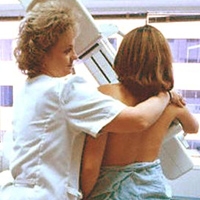Low-Cost, Low-Tech Way to Save Lives
November 17, 2006 / by Edward North-Hager- Research
Making a mammogram a part of a woman’s regular check-up is important because early detection is key in beating breast cancer.
But for years, many low-income, ethnic women who go to the trouble of getting examined fail or delay the next tests such as a repeat mammogram and biopsy – follow-ups that could save their lives.
Kathleen Ell of the USC School of Social Work thought she might have a way to change that.
With a grant from the Centers for Disease Control and Prevention, Ell conducted a randomized clinical trial that compared about 200 women who had abnormal mammograms.
Half proceeded by themselves. Scheduling appointments, reaching out for answers and making any arrangements was up to them.
With the other half, Ell used a relatively new system called patient navigation that she has helped pioneer.
The low-tech and low-cost intervention uses telephone calls to assess the patient’s understanding of her abnormal screen and the barriers that might prevent her from keeping follow-up appointments.
The intervention also helps the patient make the appointment and take advantage of existing community-based services that would enable her to keep appointments, as well as navigate the health-care system.
The results were significant.
While 66 percent of the control group followed through with diagnosis, 90 percent of those that received patient navigation kept their follow-up appointments. And for those ultimately diagnosed with cancer, they entered treatment in a timely manner. The study is scheduled to be published in the December issue of Preventive Medicine.
Ell has been studying patient navigation since 1997, but this is her first randomized controlled study, which she said is the gold standard. As a result of research by her and others, President Bush signed a bill into law last year to test whether trained counselors can help patients with cancer or other chronic diseases get diagnosed and treated earlier and more efficiently.
Ell already knew why women said they didn’t go back to the doctor.
The disparity in care was the first glaring reason – more affluent practices only require one visit because the radiologist can read the mammogram immediately. But there was also a language barrier.
Some women didn’t realize the importance of getting an early diagnosis. For others, the specter of cancer scared them away. Transportation, child care or care for their elderly parents was another factor. And, of course, there was the issue of money.
Ell educated workers to make follow-up calls to encourage the women to make appointments. When obstacles arose, the navigators helped the patients use the transportation, child and elder care programs that were already in place. The navigators also knew the federal and state monies that were waiting to be used for such occasions.
“Our health-care system is not easy. It’s very fragmented,” Ell said. “You may be going to a variety of clinics and physicians, and if you are low income, you have more barriers. Not everybody gets time off from work for a doctor’s appointment. All of those barriers ultimately make it more costly, because it’s more costly to treat cancer at a more advanced stage of disease.”
To reference the work of our faculty online, we ask that you directly quote their work where possible and attribute it to "FACULTY NAME, a professor in the USC Suzanne Dworak-Peck School of Social Work” (LINK: https://dworakpeck.usc.edu)
